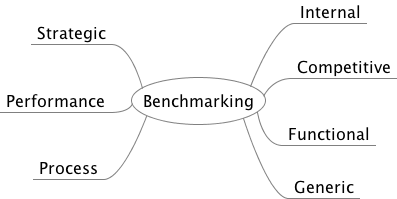Benchmarking is a strategy tool used to compare the performance of the business processes and products with the best performances of other companies inside and outside the industry.
Benchmarking is the search for industry best practices that lead to superior performance.
Comparing your own business to a rival is essential when competing. Without it, you would never know how successful your performance is in a market or whether you perform one or another task better than your competitor does. For example, 80% Customer Satisfaction (CSAT) scores might look great for you or even compared to your industry’s average, but what if your competitors’ CSAT scores are over 98%? In this situation, your 80% CSAT score should be significantly improved.

Benchmarking Mindmap
According to Camp[1]:
benchmarking is simply Finding and implementing the best business practices
It’s a very important tool in strategic management, because it often reveals how well your organization performs compared to rivals. Benchmarking is one of the most recognized and widely used tools of all the business strategy tools[2]. There are different types of benchmarking the managers can use
Strategic
Managers use this type of benchmarking to identify the best way to compete in the market. During the process, the companies identify the winning strategies (usually outside their own industry) that successful companies use and apply them to their own strategic process. It is also common to compare the strategic goals in order to spot new strategic choices.
Performance
It is concerned with comparing your company’s products and services. This tool focuses on product and service quality, features, price, speed, reliability, design and customer satisfaction. In addition, you can benchmark anything that has measurable metrics, including processes. This approach compares the strength of products and services against competition.
Process
It requires to look at other companies that engage in similar activities and to identify the best practices that can be applied to your own processes in order to improve them. Process benchmarking is a separate type of benchmarking, but it usually derives from performance benchmarking. This is because companies first identify the weak competing points of their products or services and then focus on the key processes to eliminate those weaknesses.
For example, an organization using performance comparison identifies that their product ‘X’ is superior in features, manufacturing quality and design, but pricier than competitor’s product ‘Y’. Then the company determines, which processes add the most to the cost of the product and seek how to improve them by looking at similar, but less cost heavy processes in other companies.
In addition to the benchmarking types, there are four approaches to benchmarking. It is important to choose the optimal approach because it reduces the costs of the activity and improves the chances to find the best standards you can rely on.

Benchmarking Mindmap
Internal benchmark
In large organizations[3], which operate in different geographic locations or manage many products and services, same functions and processes are usually performed by different teams, business units or divisions. This often results in processes performed very well in one division but poorly in another.
Internal benchmarking compares separate teams, units or divisions internal to an organisation. This exercise identifies the entities that are work better and share the knowledge with other teams to achieve higher performance. Usually, companies benchmark internal units to create channels to diffuse best practices, promote knowledge sharing, and improve communications. If such systems are in place, you can skip the internal benchmarking exercise.
External / Competitive benchmark
Competitive benchmarks refer to a process when a company compares itself with the competitors inside its industry. External benchmarking looks both, inside and outside the industry to find the best practices. Hence, the term, competitive benchmarking. Competitive benchmarking, often used with performance benchmarking, compares products and services. Strategy or process benchmarking aren’t viable options because it’ll be very hard to find a competitor that is willing to share sensitive information.
So, your client will never outcompete its rival if you use the competitor’s information to articulate a strategy or processes superiority. Besides, external benchmarking is a more beneficial approach to use due to higher possibilities of finding the best practices.
Functional benchmark
Managers of functional departments find it useful to analyze how well their functional area performs compared to functional areas of other companies. It is quite easy to identify the best marketing, finance, human resource or operations departments, in other companies, that excel in what they do and to apply their practices to your own functional area. This way the companies can look at a wide range of organizations, even unrelated ones, and instead of improving separate processes, they can improve the whole functional areas.
Generic benchmark
According to Kulmala[4], it refers to comparisons, which:
focus on excellent work processes rather than on the business practices of a particular organization
For example, your company tries to improve its marketing capabilities and benchmarks itself against a competitor. While observing the competitor’s marketing processes, you notice how well their human resources are managed using data analytics. This gives you an idea to implement the necessary analytics capability in your own organisation to improve its overall performance.
References
| ↑1 | Camp, R.C. (1989). Benchmarking. The Search for Industry Best Practices That Lead to Superior Performance. ASQC Quality Press |
|---|---|
| ↑2 | Spendolini, M. (1992). The Benchmarking Book. American Management Association |
| ↑3 | How Great Companies Think Differently |
| ↑4 | Paula Kyrö, Juhani Kulmala: The roots and the content of benchmarking |




